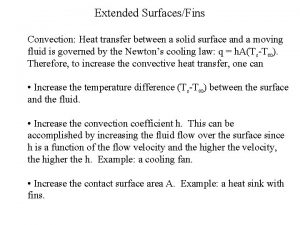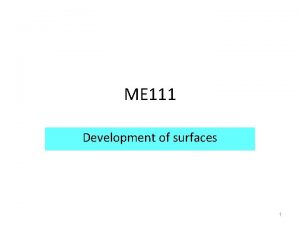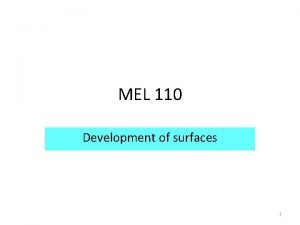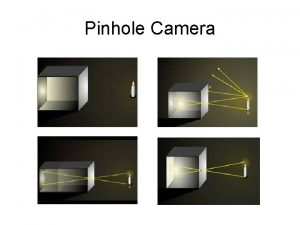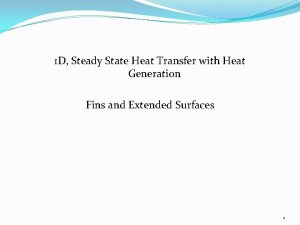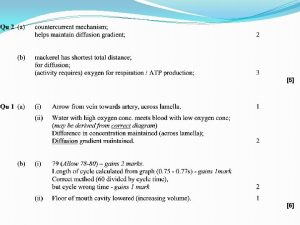Module 7 Exchange Surfaces 7 1 Special surfaces
















- Slides: 16

Module 7 Exchange Surfaces 7. 1 Special surfaces for exchange



Amoeba Build a amoeba! e. g. A cube measuring 1 cm x 1 cm Mouse Build a mouse! e. g. A block measuring 3 cm x 3 cm • What is the surface area of each ‘organism’? • What is the volume of each ‘organism’? Ø Calculate and compare the surface area to volume ratio for the ‘amoeba’ and ‘mouse’ ØWhat do you notice about the relationship between the size of the organism and it’s surface-area-to-volume-ratio Øhttps: //www. youtube. com/watch? v=xu. G 4 ZZ 1 Gbz. I

Learning Objectives • Explain in terms of surfacearea-to-volume-ratio, why multicellular organisms have specialised exchange surfaces and single celled organisms do not Success Criteria • List why organisms need special exchange surfaces (Grade E - D) • Describe and explain the features that make an exchange surface efficient (Grade C –B) • Explain in terms of surface area to volume ratio how multicellular organisms are different to unicellular organisms (Grade B – A)

Why organisms need special exchange surfaces • Living cells must be able to take up simple substances from their environment. • They also need to remove waste products from metabolic activities. • Task - On your post it write down one of these substances /products - Stick your post it on the board and explain why it is important Looking at your model of a single-celled and multicellular organism describe how they exchange these important substances/products use keyword surface • List why organisms need special area-volume-ratio exchange surfaces (Grade D – C)

Single Celled Organisms • Exchange gases, nutrients and wastes can diffuse directly in and out of the cell across the cell surface membrane. They have a large surface-area-volume-ratio. • Diffusion rate is quick as substances only have to travel small distances

Multicellular Organisms need special exchange surfaces • Diffusion across the outer membrane is too slow for 3 reasons • 1) some cells are deep within the body there is a big distance between them and the outside environment

• 2) low surface area to volume ratio – It is difficult to exchange enough substances to supply a large volume of oxygen through a small outer surface

• 3) Multicellular organisms are often very active which means a lot of cells are respiring very quickly need a constant, rapid supply of glucose and O 2 • Molecules such as hormones or enzymes are made in one place but needed in another • Food will be digested in one organ system and need to be transported to every cell for use in respiration and other aspects of cell metabolism • Waste products of metabolism need to be removed and transported to excretory systems

Job Advert • Create a job advert for an exchange surface. Include all the feature necessary to make a good exchange surface. • Describe and explain the features that make an exchange surface efficient (Grade C –B)

Examples of specialised exchange surfaces • Alveoli of the lungs

Examples of specialised exchange surfaces • Small intestine

Examples of specialised exchange surfaces • Liver- blood sugar

Examples of specialised exchange surfaces • Root Hair Cells in Plants

Plenary • Explain why large, active organisms need specialised surfaces for exchange. (3 marks) • Large mammals have a high demand for oxygen for respiration, which can’t be met by diffusion alone as their surface area : volume ratio is too low. A specialised exchange surface gives a greater area, so more oxygen can be absorbed and more carbon dioxide can be removed. • Explain in terms of surface area to volume ratio how multicellular organisms are different to unicellular organisms (Grade B – A)
 Gas exchange key events in gas exchange
Gas exchange key events in gas exchange Determination of exchange rate
Determination of exchange rate Voluntary exchange activity the pearl exchange
Voluntary exchange activity the pearl exchange Module 43 featured worksheet 1 fixed exchange rate policy
Module 43 featured worksheet 1 fixed exchange rate policy C device module module 1
C device module module 1 Heat transfer from extended surfaces fins
Heat transfer from extended surfaces fins Efficient simplification of point-sampled surfaces
Efficient simplification of point-sampled surfaces Surfaces of thyroid gland
Surfaces of thyroid gland Methods of development of surfaces
Methods of development of surfaces Surface development of cube
Surface development of cube Reflection
Reflection Parallel line development method
Parallel line development method Heat transfer from extended surfaces fins
Heat transfer from extended surfaces fins Testing aspheric surfaces
Testing aspheric surfaces Friction can act between two unmoving, touching surfaces.
Friction can act between two unmoving, touching surfaces. Aircraft control surfaces and components
Aircraft control surfaces and components Tool mark impressions
Tool mark impressions





